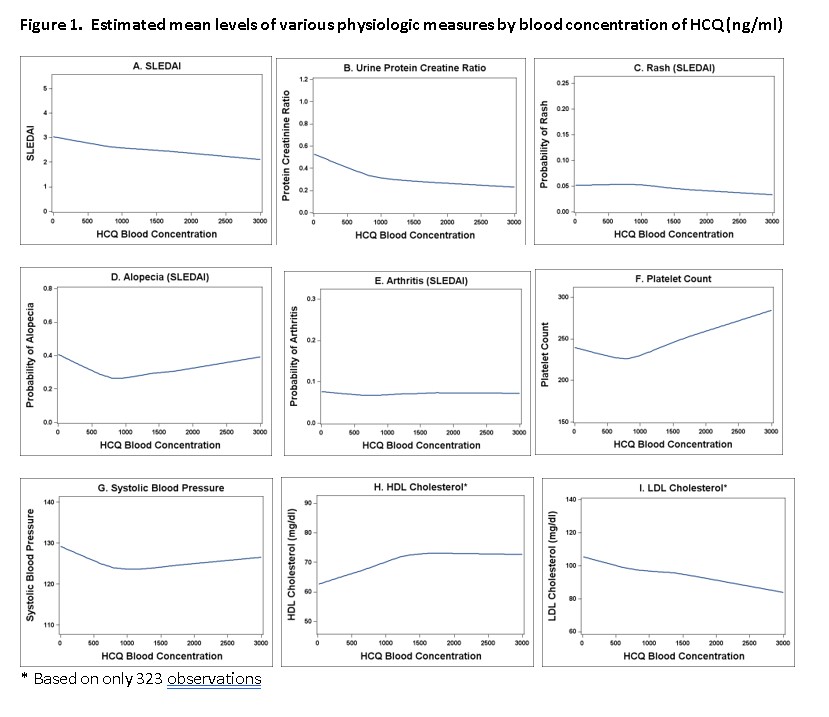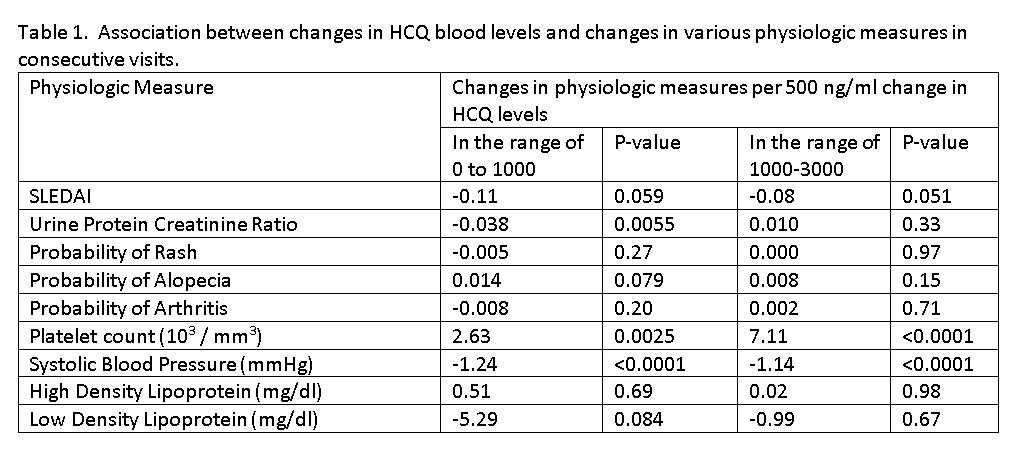Session Information
Session Type: Poster Session D
Session Time: 8:30AM-10:30AM
Background/Purpose: In SLE, treatment with hydroxychloroquine (HCQ) has been shown to be associated with reduced SLE flares and reduced risk of damage in several different organ systems. However, high HCQ blood levels over time are associated with retinopathy. To provide insight into the optimal treatment strategy, we determined the level of blood HCQ concentration needed for protection against several different manifestations of SLE disease.
Methods: The analysis was based on data from a large single-center clinical cohort of patients with SLE. Since 2013, whole blood levels of HCQ were measured at quarterly clinic visits among patients prescribed HCQ using liquid chromatography–tandem mass spectrometry. At each visit, numerous disease activity measures were performed (a visual analog scale for each organ and SLEDAI). Initially, we used loess to examine the shape of the cross-sectional relationship between blood levels of HCQ and average values of disease activity or cardiovascular risk factors. We then examined the association between changes in HCQ and concurrent changes in disease activity in consecutive visits from the same patient using a mixed effects model.
Results: The analysis was based on 10,370 clinic visits from 1095 different patients who were predominately Caucasian (46%) or African American (43%). Figure 1 shows the cross-sectional relationship between HCQ blood levels and various measures of SLE disease activity and other physiologic measures. Higher HCQ blood levels were associated with lower mean SLEDAI (Fig 1A), lower urine protein-creatine ratio (Fig 1B), lower systolic blood pressure (Fig 1G) and higher platelet counts (Fig 1F). For some measures, the relationship was strongest over HCQ concentrations in the range of 0 to 1000 ng/ml. Table 1 shows the association between changes in HCQ concentration between two consecutive visits and concurrent changes in physiologic measures. Within a patient, increases in HCQ concentration in the range of 0 to 1000 ng/ml were associated with decreases in urine protein-creatinine ratio, decreases in systolic blood pressure, and increases in platelets. Increases in the range of 1000 to 3000 ng/ml were associated with decreases in systolic blood pressure and increases in platelet counts. Surprisingly, changes in blood concentration were not significantly associated with changes in skin or joint manifestations of SLE.
Conclusion: We found that small but statistically significant improvements in physiologic measures are associated with increases in blood HCQ concentration. Interestingly, for most measures, the impact of increases in HCQ were seen primarily in the range of 0 to 1000 ng/ml, suggesting that 1000 ng/ml may be a good target to achieve protection without accruing a high risk of retinopathy.
To cite this abstract in AMA style:
Magder L, Petri M, Goldman D. Hydroxychloroquine Blood Levels Are Associated with Reduced SLE Disease Activity and Improvements in Cardiovascular Risk Factors [abstract]. Arthritis Rheumatol. 2021; 73 (suppl 9). https://acrabstracts.org/abstract/hydroxychloroquine-blood-levels-are-associated-with-reduced-sle-disease-activity-and-improvements-in-cardiovascular-risk-factors/. Accessed .« Back to ACR Convergence 2021
ACR Meeting Abstracts - https://acrabstracts.org/abstract/hydroxychloroquine-blood-levels-are-associated-with-reduced-sle-disease-activity-and-improvements-in-cardiovascular-risk-factors/


